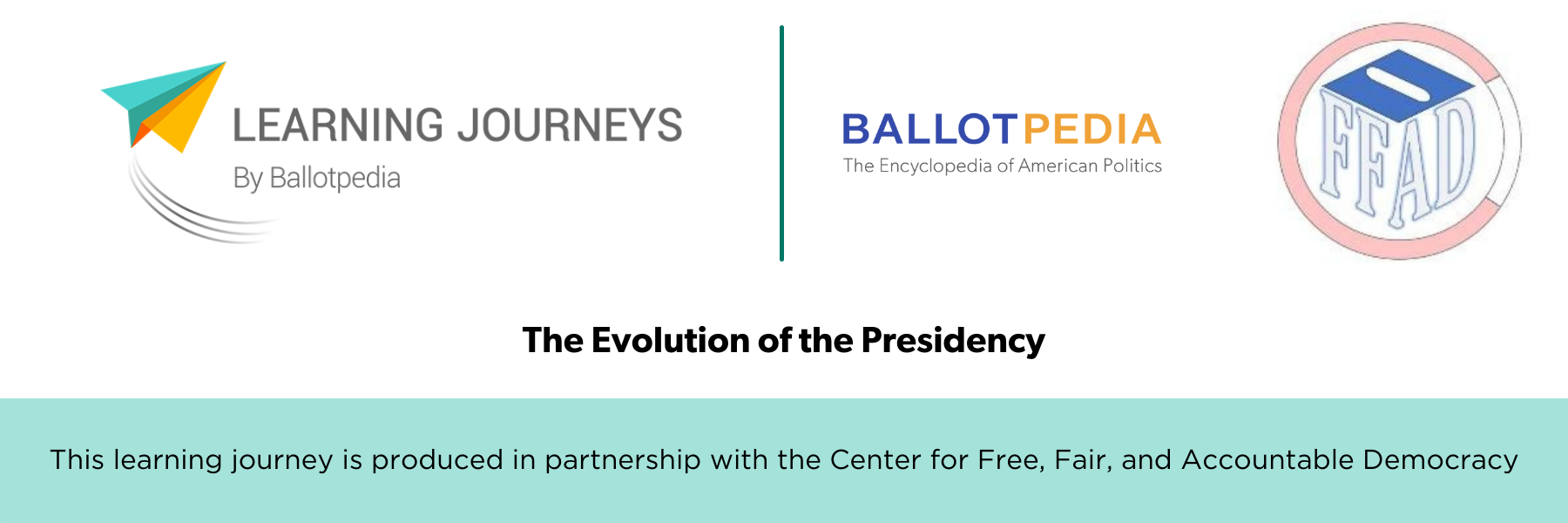Welcome back to our Learning Journey on the evolution of the Presidency over time. Today, we’re going over implied powers.
“Implied powers” refers to powers that are not enumerated in the Constitution. These powers appeared in practice because they are necessarily implied by Constitutional obligations, notably the Take Care Clause that requires the president to “take care that the laws be faithfully executed.” Two of the most important implied powers are the power to issue executive orders and the power to decide which laws, rules, and regulations to enforce.
Executive Orders
Presidents can use executive orders to create laws or to modify laws, rules, and regulations. As an example of law creation, President Truman issued Executive Order 9981 in 1948 to desegregate the military. In 1965, President Johnson signed Executive Order 11246 to require equal opportunity for minorities in federal contractors’ recruitment, hiring, training, and other employment practices. Other examples of executive orders include the 1863 Emancipation Proclamation used to free enslaved people during the civil war and President Roosevelt’s order in 1942 to force the internment of Japanese citizens during World War Two. Executive orders have also been used to create federal agencies. The Department of Homeland Security is an example (Executive Order 13228). Executive orders are also used to modify rules and regulations.
Executive orders are an implied power based on the Take Care Clause. They carry the force of law only when they are grounded in an act of Congress or in the Constitution. This requirement was underlined by the Supreme Court in Youngstown Sheet & Tube Co. v. Sawyer (1952). In that case, President Truman had attempted, as a matter of national security, to take over the country’s steel mills while they were dealing with labor union strikes. The Supreme Court ruled the executive order was unconstitutional because it was not based on any existing laws or constitutional provisions. Executive orders are therefore built upon interpretations of existing laws and Constitutional clauses. Many of these interpretations come from the Office of General Counsel located in the Office of Management and Budget, or from the Office of White House Counsel located within the White House staff.
The courts have been generous in how they assess the constitutionality of various executive orders. They have allowed for implied powers as well as specifically delegated or shared powers, and even allowed for Congressional support after the fact.
Executive orders can be nullified by Congress but only with difficulty. Congress could adopt a law to overturn an executive order, but that law could be vetoed by the president. Congress could then seek to overturn the veto with two-thirds majority votes in the House and the Senate, as required by the Constitution. Historically, Congress has overridden only ten percent of all presidential vetoes.
Executive orders may seem like an attractive option in the face of Congressional obstruction, but they come at a cost because they are easily reversed by new presidents. The fate of the Presidential Records Act of 1978 is an example of how presidents can modify laws. The 1978 law declared all records of former presidents as the property of the federal government, to be made public 12 years after they left office. When George W. Bush became president, he signed Executive Order 13233, restricting access to presidential records with military, diplomatic, national security, or other sensitive information. The order was later revoked by Barack Obama’s Executive Order 13489.
Enforcement Discretion
The Supreme Court has provided the Executive Branch with significant discretion in deciding which laws and regulations should be enforced and which should not. The Supreme Court generally resists reviewing Executive Branch enforcement decisions. This is because the Appellate Courts and the Supreme Court have interpreted the Take Care Clause as ensuring presidential control over the enforcement of federal law. Decisions not to enforce a law or regulation are subject to agency discretion and are not subject to judicial review under the Administrative Procedure Act. In Heckler v. Chaney (1985), the Supreme Court ruled that an “agency’s decision not to take enforcement action should be presumed immune from judicial review.”
Congress can narrow the Executive Branch room for maneuver. In Heckler v. Chaney, the Court explained that agency discretion in non-enforcement decisions could be overcome proactively if substantive law provided guidelines for the agency to follow in exercising its enforcement powers, or reactively if an agency has “’consciously and expressly adopted a general policy’ that is so extreme as to amount to an abdication of its statutory responsibilities.”
Enforcement discretion can create worries about partisanship and separation of powers. Is the lack of enforcement of some law or regulation due to a genuine lack of capacity, or is it a maneuver to evade Congressional intent? The use of adversarial “signing statements” also exacerbates worries about the separation of powers. When presidents sign legislation into law, they often attach a signing statement as a way to associate their own opinions with the new law. These statements are often simple explanations of why a president supported Congress in enacting a law.
Since the Reagan administration, however, signing statements have also been used to indicate presidential opinions on preferred interpretations of some laws, preferences in how some laws should be selectively implemented, or concerns over the constitutionality of selected portions of some laws. Although signing statements, by themselves, do not carry the force of law, presidential administrations appear to expect they might eventually enter into the legal record – potentially establishing eventual unilateral executive discretion to depart from the law. Thus far, however, the Courts have not referenced any signing statements in any of their decisions.
Go Deeper:
Thank You!
Thank you for joining us on this Learning Journey about the evolution of the presidency over time. Interested in learning more? Check out our other content at Ballotpedia and CFFAD.
|

